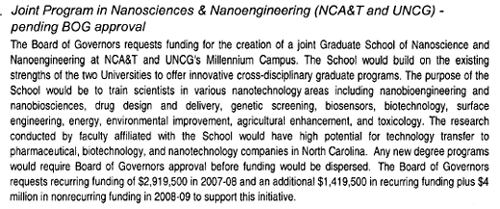| In
2003-04, with the backbone of North Carolina's
industrial economy Tobacco, Textiles, and Furniture in
recession and appropriations for UNC-System taking an
ever increasing multi-billion dollar bite out of state's
coffers, North Carolina's Legislature thru House Bill
1264 (HB 1264) direct UNC-BOG to contract a private
consulting firm that had experience in higher education
to conduct a comprehensive study (HB 1264 Study) of the
mission and educational program needs to ensure that the
State's citizens are academically prepared and equipped
for current job opportunities and jobs of the future in
North Carolina's growing knowledge economy. HB 1264
Study was
designed to
|
 |
|
provide information and
recommendations that would assist the General Assembly
in setting priorities for funding to address the
strategic higher education needs of the State.
Staying a step
ahead
stated
North Carolina A&T State
University is well positioned to grow programs in some
of the areas identified as emerging industries, citing
Objective 2.2: Increase access to University
intellectual property and resources (faculty, students,
research. Create market-oriented university research
clusters to better communicate research programs. [3] |
|
Identified Emerging Markets [4] |
[4][
examples of research clusters created by NC
A&T are the following: |
-
Advanced
Manufacturing
-
Advanced Materials,
including Chemicals, Plastics and
Nanotechnology
-
Biotechnology and
Pharmacology
-
Computing, Software
and the Internet
-
Design and Arts
-
Logistics and
Distribution
|
-
Public Health
-
Biotechnology, Bio
& Food Sciences
-
Advanced Materials
& Nanotechnology
-
Computational
Science & Engineering
-
Leadership &
Community Development
-
Information
Sciences & Technology
-
Transportation &
Logistics
|
|
|
|
Nanotechnology & Biotechnology Should have been NC A&T
Signature Program |
|
HB 1264(6)
recognized the Historic significance of Historical
Minority Institutions (HMI), ordered the University to
formulate signature programs at them and not to diminish
their role. The study stated " “Signature programs”
have been defined as those that are distinctive, that
build on existing strengths, that advance the
institution’s profile, and that serve regional and/or
state economic transformation needs." Study identified
as an emerging area Advanced Materials --
Nanotechnology. |
 NC
A&T is "well known in areas such as advanced
materials,
nanotechnology,
computational science, and says
N. Radhakrishnan, former for research and
economic development at N.C. A&T. The school
also has significant strengths in other areas,
including biotechnology, energy and the
environment, information sciences and
technology, logistics and transportation
development. NC
A&T is "well known in areas such as advanced
materials,
nanotechnology,
computational science, and says
N. Radhakrishnan, former for research and
economic development at N.C. A&T. The school
also has significant strengths in other areas,
including biotechnology, energy and the
environment, information sciences and
technology, logistics and transportation
development. |
 |
|
All these
endeavors are aligned in eight research
clusters that bring faculty together across
disciplines to
develop large research projects.
These research clusters run in parallel with a
number of multidisciplinary centers and
institutes at N.C. A&T, which develop
partnerships with private and corporate
sponsors, educational institutions, and
government agencies. This includes two US Army
Centers of Excellence that are working on
projects to enhance the capabilities of soldiers
on the battlefield. [3] |
|
|
|
"Almost
all of the occupations which will be affected by
nanotechnology will require a BS in engineering with a
broad, interdisciplinary and multi-disciplinary
approach, and an understanding not only of electrical,
mechanical
and civil
engineering, but biology, physics and chemistry as well
". |
|
In 2006 in the category of
Doctorial Granting Universities NC A&T was
rated as a High Research University in the
Carnegie Foundation classification of colleges
and universities.
NC A&T
the
largest producers of BS. and PhD minority
engineers in the country, offers approved
master's degrees in
Civil
|
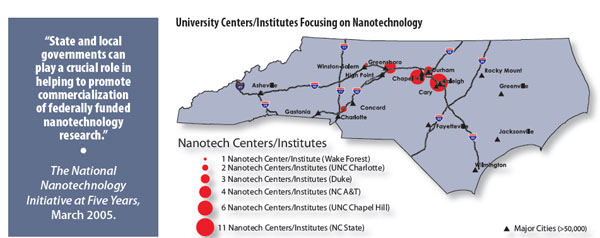 |
|
|
University Centers/Institutes Focusing on
Nanotechnology, A Roadmap for Nanotechnology in
North Carolina’s 21st Century Economy, APRIL
2006, NC Board of Science & Technology |
|
|
Engineering, Chemistry, Biology,
Industrial Systems & Systems Engineering,
Electrical Engineering, Mechanical Engineering,
Computer Science, Chemical Engineering, Physics,
Computational Science and Engineering, as well
as doctoral degrees in Energy and Environmental
Systems |
|
 |
|
PCG/UNC-NCCCS/UNC Interim report
3.doc/RB.SP.PC.CR.ATPCC.1/CC.14/10May05 (34)
|
 |
|
Southern
Association of Colleges and Schools (NC A&T) |
|
Engineering, computational Science and Engineering,
Electrical Engineering, Mechanical Engineering, and
Industrial and Systems Engineering. |
|
Nano scale
Technologies are Experimental |
|
In 2011 HMI North
Carolina A&T for the 7th consecutive year
garnered the third largest highest amount of
sponsored research in 17 constituent UNC system
surpassed only by UNC flag ships UNC-Chapel Hill
and NC A&T holds patents in Advanced Materials,
Nanotechnology, |
Biotechnology, Computational Science,
Environmental Sciences, Transportation Systems,
and Public Health, for seventh consecutive
year achieved the third highest research
funding in the 16-constituent University of
North Carolina System with over $60 million
dollars.
|
North Carolina A&T Nano Centers |
-
Center for Advanced Materials and
Smart Structures
-
Center for Nanoscale
Chemical-Electrical-Mechanical
Manufacturing Systems
-
Engineering Research Center for
Revolutionalizing Metallic
Biomaterials
-
Center for Nanoscience and
Nanomaterials
|
|
UNC at Greensboro Nanoscience Centers |
-
Center of Research Excellence in
Nanobiosciences
Source: North Carolina Board of
Science and Technology |
|
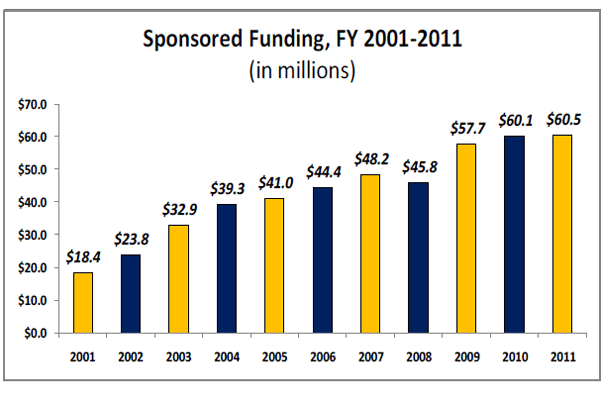 |
|
NC
A&T Sponsored Research 2001 - 2011
|
|
|
NCA&T State University has been funded
at an average rate of $3-5 million per
year in the area of nanoscience and
nanotechnology. Most of the research in
nanoengineering is done in the Center
for Advanced Materials and Smart
Structures (CAMSS). Several Centers and
projects are under CAMSS, including the
NSF Center for Research Excellence in
Science and Technology (CREST), the DoD
Center for Nanoscience, Nanomaterials
and Multifunctional Materials (CNN) for
Homeland Security, the NSF Nanoscale
Science and Engineering Center (NSEC),
the NSF project on US/Europe Materials
Collaboration: Self-Organized
Nanostructured Thin Films for Catalysis,
the NSF project on Nanoscale
Interdisciplinary Research Teams (NIRT),
the NSF Major Research Instrumentation
for Nanoengineering Research, and the
NSF Nanotechnology Undergraduate
Education (NUE) program. CAMSS also
facilitates many of the materials
research activities of the NASA-National
Institute for Aerospace (NIA). In
addition, the Center for Composite
Materials Research (CCMR) does research
in nano-enhanced composite materials and
the Army Center of Excellence for
Battlefield Capability Enhancements
(Flexible Displays) does research in
material characterization and
development of novel displays. [ ] |
|
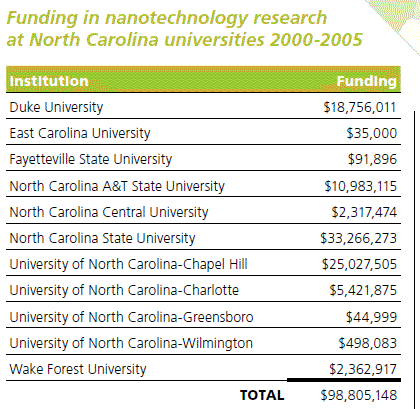 |
|
| |
| |
|
"With
the millions of federal dollars flowing to this
center, what [ we] can do to increase the
economic opportunities in Guilford County, the
Triad and in the state of North Carolina is
truly phenomenal," said Erskine Bowles ,
president of the UNC system. [A&T lands prized
NSF center][31].
|
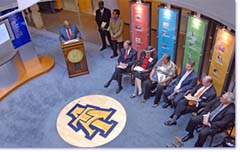 N.C.
A&T Awarded NSF
Engineering Research
Center N.C.
A&T Awarded NSF
Engineering Research
Center
Shena Crittendon,
Greensboro – North
Carolina A&T State
University has been
awarded a grant for an
Engineering Research
Center (ERC) from the
National Science
Foundation (NSF).
Engineering Research
Center grants represent
major investments by NSF
in partnership with
industry to transform
engineering research and
education. The centers
aim to produce
innovative technologies
and engineering
graduates to
significantly enhance
the competitiveness of
the U.S. economy. Award
funding has been
approved at $18 million
for the initial five
years, with a potential
duration of 10 years.
|
|
The NSF ERC for
Revolutionizing Metallic
Biomaterials at A&T will
conduct research in the
areas of biomedical
engineering and nano-bio
applications and is in
partnership with the
Universities of
Cincinnati and
Pittsburgh. It also has
a global technical
partner in Germany’s
Hannover School of
Medicine and a global
cultural and outreach
partner in the Indian
Institute of Technology,
Madras, India.
California State
University at Los
Angeles will serve as an
outreach partner in the
USA. The ERC has
partnerships with
pre-college institutions
in North Carolina to
involve teachers and
students in engineering;
it has partnerships with
a broad range of North
Carolina organizations
devoted to
entrepreneurship and
small business
development.
A&T’s ERC will be led by
Dr. Jagannathan Sankar,
professor of
engineering. Dr. William
Wagner from the
University of Pittsburgh
and Dr. Mark Schulz from
the University of
Cincinnati will serve as
co-directors. Dr. Devdas
Pai, professor of
engineering at A&T, will
lead educational aspects
of the ERC. The ERC
research will focus on
three engineered
systems: Craniofacial
and Orthopedic
Applications;
Cardiovascular Devices;
and Responsive
Biosensors for Implants.
The ERC will introduce
new metallic materials,
devices, and systems
that have the potential
to exhibit all the
|
|
necessary attributes of
an ideal foundation or
“scaffold” and that
promise to completely
transform the field of
regenerative medicine.
Similarly, innovative
metallic materials will
be introduced as stents
in the treatment of
cardiovascular problems.
Nano sensors will be
developed to study the
efficacy of these
devices as part of this
research. More than
eight companies will be
associated with the ERC
to provide input for the
direction of research as
well as a conduit to
transfer the technology
to the real world. NC
A&T will also start a
new department of
bioengineering in
conjunction with this
ERC. The department will
|
|
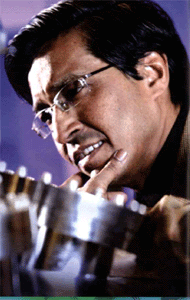  NC
A&T State University Researcher
Receives UNC Board of Governors’
Highest Faculty Honor NC
A&T State University Researcher
Receives UNC Board of Governors’
Highest Faculty Honor
Joni Worthington
Jagannathan Sankar,
Distinguished University
Professor of mechanical
andchemical engineering and
White House Millennium
Researcher at at North Carolina
Agricultural &Technical State
University, received the O. Max
Gardner Award today |
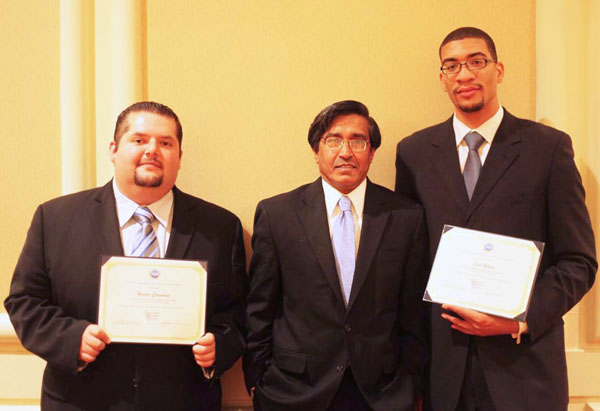 A&T
MECHANICAL ENGINEERING STUDENT
WINS FIRST TEST-BED COMPETITION
FOR INNOVATION AND TRANSLATION
AT NSF ERC ANNUAL CONFERENCE A&T
MECHANICAL ENGINEERING STUDENT
WINS FIRST TEST-BED COMPETITION
FOR INNOVATION AND TRANSLATION
AT NSF ERC ANNUAL CONFERENCE
Hector Carmona, California State
University, Dr. Jag Sankar,
Director of the Engineering
Research Center for
Revolutionizing Metallic
Biomaterials and Leon White,
N.C. A&TT |
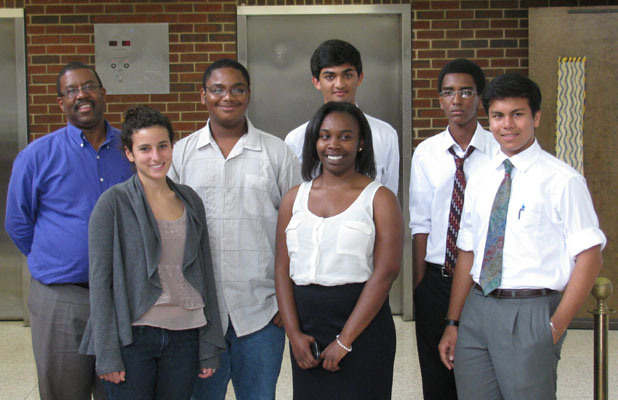 HIGH
SCHOOL STUDENTS SPEND SIX WEEKS
AS BIOENGINEERING RESEARCHERS
(NCA&T) HIGH
SCHOOL STUDENTS SPEND SIX WEEKS
AS BIOENGINEERING RESEARCHERS
(NCA&T)
NCA&T Photo: From left: Faculty
advisor Vernal Alford and Young
Scholars Shira Chandler, Dondre
McCaskill, Brianna Hargett,
Aditya Badve, Ephraim Bililign
and Aditya Garg |
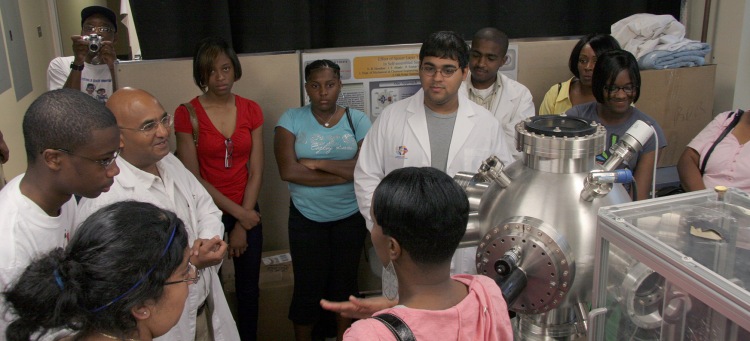 High
school students see the
pulsed laser deposition High
school students see the
pulsed laser deposition
|
|
North Carolina A&T State
University was selected
as a host institution
for Brazilian students
participating in the
Brazil Science without
Borders program. The
U.S. State Department
reports that last year,
President Obama and
Brazilian President
Rousseff, “set
complementary goals for
international education.
President Obama
announced the “100,000
Strong for the Americas”
initiative to increase
international study with
a target of 100,000
students from Latin
America and the
Caribbean studying [in
the] United States, and
a reciprocal 100,000
students from the United
States studying in the
Latin American and the
Caribbean region.” |
|
offer BS, Masters and PhD degrees . |
|
|
|
|
